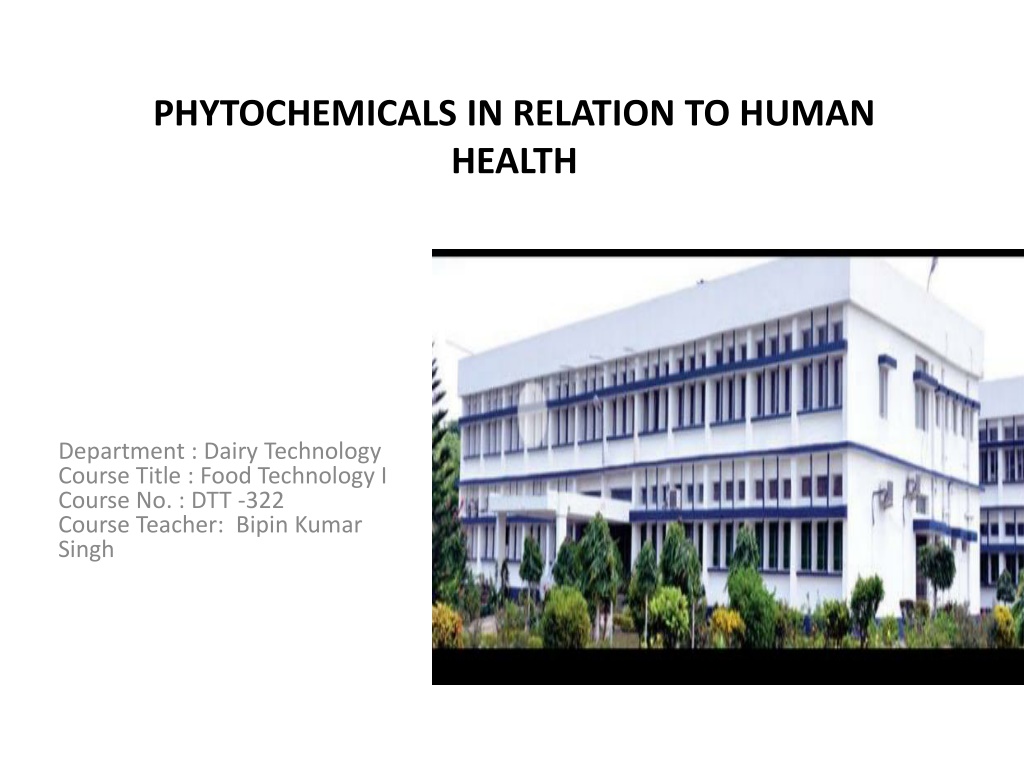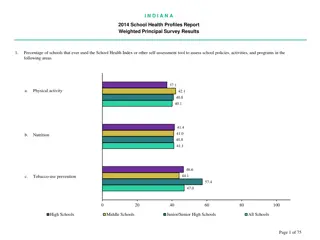The Impact of Phytochemicals on Human Health and Disease Prevention
Phytochemicals found in fruits and vegetables play a crucial role in preventing diseases such as cataract, cancer, and cardiovascular issues. These plant-derived compounds act as antioxidants, combating free radicals and reducing the risk of degenerative diseases. Specific phytochemicals like phytoestrogens, organosulphur compounds, glucosinolate, and others have proven health benefits, contributing to overall well-being and vitality.
Download Presentation

Please find below an Image/Link to download the presentation.
The content on the website is provided AS IS for your information and personal use only. It may not be sold, licensed, or shared on other websites without obtaining consent from the author. Download presentation by click this link. If you encounter any issues during the download, it is possible that the publisher has removed the file from their server.
E N D
Presentation Transcript
PHYTOCHEMICALS IN RELATION TO HUMAN HEALTH Department : Dairy Technology Course Title : Food Technology I Course No. : DTT -322 Course Teacher: Bipin Kumar Singh
Phytochemical Consumption of fruits and vegetables has since long been associated with lesser incidences of certain diseases like cataract, scurvy, cancer and CVD in populations consuming them. The disease prevention ability of fruits and vegetables is mainly attributed to the photochemical present in minor quantities. Photochemical - consisted Chemicals . Phyto from Greek word for plants, denoting their plant origins and it refers to the chemicals which are present in plant. These photochemical are secreted or developed as a part of the plants own defence mechanism against environmental insult and fortunately beneficial to human beings. These photochemical are very effective anti-oxidants thus checks free radical mediated degenerative diseases like cancer, CHD etc. of two words Phyto and
Photochemical with Proven Health Benefits Phytoestrogens Organosulphur compounds Glucosinolate Carotenoids and flavonoids Lycopene and cancer prevention Flavanoids Phytosterols Other Phytochemicals
Phytoestrogens Phytoestrogens are a broad group of plant-derived compounds that structurally mimics endogenous 17 betaestradiol. Two major phytoestrogens, which are of great importance from perspectives, include lignans (Flaxseed) and isoflavones (soy bean). Isoflavones are flavonoids compounds and major flavonoids that have been identified in soybeans are genistein, daidzein and glycitein. These compounds exist naturally in soy bean in several glycoside forms, but it is the aglycone form that is biologically active. nutritional and healt
Organosulphur compounds These compounds are also called as Promise of Garlic . Garlic and other alliums are popular recipe seasoning, but these also have long been promoted as a medicinal agent. Garlic and other alliums onions, chives, leeks and scallions contain allylic sulphides.
Glucosinolate About 100 glucosinolate have been identified in more than 450 plant species including 16 higher plant families, marine sponges and red algae. Cruciferous vegetables comprising of cauliflower, broccoli, radish, horseradish, cabbage, Brussels sprout contain relatively glucosinolate, a Glucosinolate (GS) are a group of glycosides stored within cell vacuoles of all cruciferous vegetables. high content anticarcinogen. of poten
Carotenoids Carotenoids are major pigments in majority of fruits and vegetables, algae, certain fungi and bacteria. Carotenoids are plant pigments with 40 carbon atoms per molecule (tetraterpenoids). They are a widely distributed group of more than 750 naturally occurring fat-soluble pigments that are synthesized by higher plants as well as some algae and photosynthetic bacteria. They are responsible for characteristic deep red, yellow or orange colour of foods including tomato, carrots, citrus fruits, egg yolk, cow milk, liver, lobster and salmon.
flavonoids Flavonoids are polyphenolic compounds and were originally regarded as nutritionally inert, are implicated in anticarcinogenic properties. A great deal of attention has been directed to the polyphenolic constituents of tea, particularly green tea. Catechins are the predominant and most significant of all tea polyphenols. The four major green tea catechins are epigallocatechin-3- gallate, epigallocatechin, and epicatechin. epicatechin-3-gallate
Contd... Sources and Toxicity: National Health and Nutrition Examination survey (NHANES) estimated intake of 200 to 250 mg/ day of flavonoids among US adults. It was also observed that widely consumed flavonoid is Flavan-3oles which accounts for 80% of flavonoid intake while the least consumed flavonoids were isoflavones and flavones . Flavonoids are found mostly in the fruits, especially citrus fruits, and vegetables, tea, red wine and legumes reported an
Phytosterols Phytosterols affect cholesterol absorption and lipoprotein metabolism. phytosterols will lower cholesterol absorption and LDL concentrations in blood. In the intestine, these phytosterols cholesterol from mixed micelles, which can decrease cholesterol absorption resulting in low levels of cholesterol in the blood High intakes of will eject
Contd.. Safety Phytosterols are generally recognized as safe substances (GRAS) scientific evidence22.The intakes of phytosterols 3g/day[22,23].However, phytosterolemia genetically were told to avoid any food supplements with phytosterol in order to reduce the risk of having premature atherosclerosis and Toxicities of Phytosterols: based on recommended are people available usually with
Contd... Disease Prevention: Plant sterols help to prevent some diseases like cardiovascular disease [25]. Clinical trials found that the consumption of phytosterols in the average of 2 g/day decreased the concentrations of serum LDL cholesterol by 9- 14%[19].The reduction in LDL cholesterol could reduce the risk of coronary heart disease (CHD) by 20% [19]. In other words, abalanced diet of plant sterol foods, which is rich in fiber, vegetables, whole grains, fruit, and low in saturated fat, is also important in reducing CHD risk























